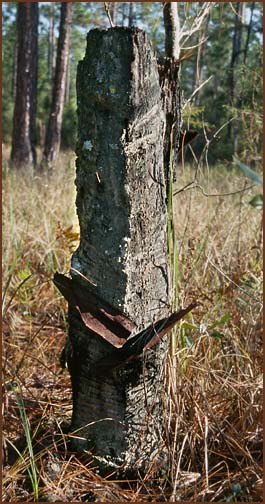Catface
Natural History

Catface on the remains of an old tree | Photo credit: Larry Kohrnak, SFRC
Trees can develop scars on their trunks from a number of different sources, including fires, vehicles, pathogens, or insects. It is not always possible to know what caused these scars by looking at them, but some scars may display a distinctive shape or pattern that indicates the source of the injury.
In the southeastern United States, the term "catface" refers specifically to the scars left behind by the extraction of sap or resin from pine trees. Pine resin was at one time in high demand because it could be used for waterproofing ships and making turpentine. The production of these goods was called the "naval stores industry" and it was once a major part of the southern economy.
Prior to the 20th century, pine resin was collected from living pine trees by a method known as "boxing," in which a collection box was cut into a living tree. The method produced a poor quality product and was very destructive, quickly leading to the death of the tree. In 1901, Charles Herty - a professor of chemistry at the University of Georgia - developed a new method of collecting the resin. The new method required less work and produced a higher quality product. Most significantly, it allowed the pine trees to continue to live and eventually be milled into lumber.
This new "Herty system," as it became known, involved the removal of a section of bark and the cutting of an angled slash or "streak" in the wood of the tree. Below the streak, an angled piece of galvanized metal was attached to the tree to direct the oozing sap into a tin cup. When one streak stopped producing sap, a new one would be cut directly above the first. Eventually the tree could have several feet of parallel slashes up its trunk. These rows of slashes resembled the whiskers on a cat, and so the term "catface" was coined to describe such trees.
Because the Herty system didn't kill the tree, many of the pines used for sap production after 1901 were left alive and standing in the forest. You can still see these trees sometimes when you walk in the woods, and sometimes the metal gutters are even still attached. The industry of collecting sap from living pine trees largely disappeared in the 1960's, so no new scars related to resin collection are being produced. Over time, as the remaining trees get older and die, a catface will become a rare sight in the forests of the southeast.
